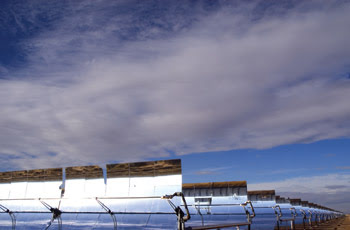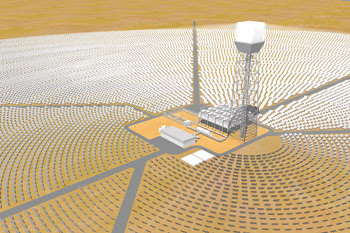Solar energy may be abundant, clean and nondepleting, but capture and distribution continue to be the main challenges.
Charles Ricker, BrightSource Energy Inc.
The sun is the source of virtually all of the energy we use. Fossil fuel energy started out as sunlight on plants. In the relative blink of a historical eye, however, we have significantly depleted the fossil fuels that took millions of years to create. Currently, they provide 86 percent of all the energy we consume, and now we have discovered that burning these fuels at this rate is threatening mankind’s very existence.
Propelled by the twin forces of extremely high prices and the awareness of the harm caused by using fossil fuels, Earth’s citizens are demanding change. Solar energy is available every day in vastly greater abundance than the totality of mankind’s needs. It is nondepleting. It is the cleanest possible form of energy. No royalties are required, no geopolitical boundaries apply, and no cartel controls its access or sets its price.
The good news is that we already know how to generate electricity from sun power economically. A company called Luz International of Los Angeles built 354 MW of utility-scale solar power plants in California between 1984 and 1990. All plants are still operating profitably today at an average of 104 percent of design capacity. Built sequentially, they use essentially the same technology, but each one is about 15 percent more cost-efficient than its predecessor.
These facilities use solar trough technology, which involves circulating a synthetic oil through vacuum tubes running down the focal point of 100-m-long parabolic troughs of curved mirrors. The oil runs through a heat exchanger at 375 °C (700 °F) to create steam, which then is used to drive a conventional steam turbine to produce electricity (Figure 1).

Figure 1. Built in the 1980s at Kramer Junction, Calif., solar thermal plants using parabolic trough technology are still in operation.
Disadvantages reconsidered
Two major concerns are raised when solar power generation is proposed as the centerpiece of our energy future. First, there is the misconception that it’s too expensive. Currently, electricity produced from photovoltaic panels costs more than electricity generated by fossil fuels; however, solar thermal power, which uses sunlight to create high-temperature steam and to drive conventional steam turbines, is less than half the price of energy produced by photovoltaic panels, and that figure is dropping. In a Nov. 18, 2007, interview with the San Francisco Chronicle, Peter Darbee, chief executive officer of Pacific Gas and Electric Co., also based in San Francisco, noted that the utility is seeing prices for solar power of 12 to 14 cents per kilowatt-hour and projected that the rate could drop to just 7 to 8 cents per kilowatt-hour.
The second concern is that solar power is available only when the sun is shining. That’s true, but fortunately, that’s also when the most energy is required. Well over 50 percent of electricity consumption takes place during hours when solar power can be generated. With the development of cost-effective storage, the solar day can be extended, and other renewable sources of power, most notably wind, can handle the balance of the demand. A visionary article in the January 2008 issue of Scientific American (“A Solar Grand Plan” by Ken Zweibel, James E. Mason and Vasilis M. Fthenakis) outlines a step-by-step program that would result in 69 percent of US electricity being provided by solar power by 2050.
Government leadership is critical because governments either own or regulate the utilities. With little leadership coming from the US government, a number of states have acted unilaterally. Several have established Renewable Portfolio Standards, which require that regulated utilities generate substantial amounts of their electricity from renewable sources by firm deadlines; e.g., 20 percent by 2010 in California.
European Union governments have been more aggressive, with a combination of feed-in tariffs that guarantee a fixed price for solar energy and incentives to help finance development of cost-effective methods of production and distribution. Spain is building 600 MW of solar thermal power plants — enough energy for up to 500,000 homes. Germany’s solar power incentives have made it the world’s largest market for residential and commercial photovoltaic solar power.
Financial institutions have awakened to the reality that solar energy is not a boutique situation but an opportunity to make real money from a paradigm shift in energy sourcing. Money is pouring into companies that demonstrate the talent and ideas to build the businesses that will hurry this transition and make substantial profits.
Growth in demand
Propelled by the necessity of meeting Renewable Portfolio Standards, utility companies are lining up to buy safe, clean, cost-effective solar power. As an example, BrightSource Energy of Oakland, Calif., has signed contracts with Pacific Gas and Electric for up to 900 MW. This contract alone will require plants that will cost $2 billion to $3 billion to construct, that will create thousands of jobs, and that will generate millions of dollars of new tax revenue for national, state and local governments.
Other solar thermal power companies are enjoying similar success: Abengoa Solar of Seville, Spain, has announced a 250-MW plant in Arizona; Ausra of Palo Alto, Calif., has announced a 133-MW plant in California; and Solel Solar Systems of Beit Shemesh, Israel, is developing a 553-MW solar park to contribute to California projects.
BrightSource Energy’s dynamic power tower technology will be used in the Pacific Gas and Electric plants. Dynamic power technology uses thousands of flat glass heliostats (mirrors) to follow the sun as it moves across the sky through the day and the seasons. The sunlight striking the heliostats is reflected onto the outward-facing tubes of a boiler on top of a tower. This concentrated sunlight superheats the water in the boiler tubes, creating very high temperature steam (550 °C, or about 1000 °F). This steam is piped to a conventional steam turbine, where it is used to generate electricity. Dynamic power technology is less costly to build and has a higher operating efficiency than parabolic trough technology (Figure 2).

Figure 2. This illustration of a 100-MW dynamic power tower plant shows the mirrors that follow the sun, the power tower with boiler tubes on top, the power block and the air-cooled condensers.
Solar thermal power is the answer. It has proved that it can provide a clean, safe, cost-effective alternative to fossil fuel power generation. The technology is ready, financing is available, and utilities are buying. The solar power era has begun.
Meet the author
Charles Ricker is senior vice president of marketing and business development at BrightSource Energy in Oakland, Calif.; e-mail: [email protected].